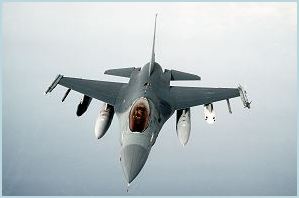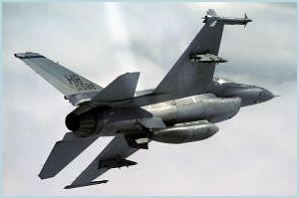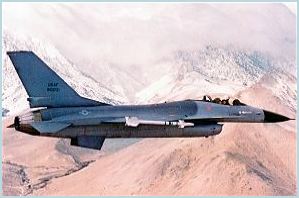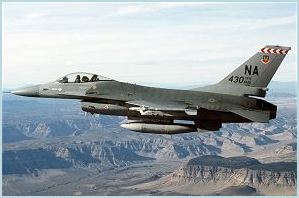|
|
||||||||||||||||||
| a | ||||||||||||||||||
|
F-16 Fighting Falcon Combat Aircraft
|
||||||||||||||||||
|
|
||||||||||||||||||
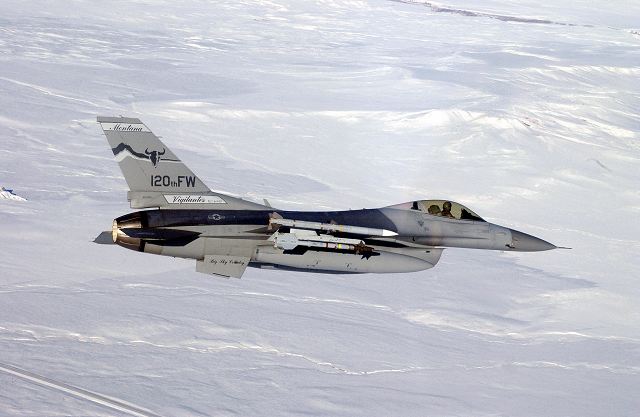 |
||||||||||||||||||
|
|
||||||||||||||||||
|
The Lockheed Martin F-16 Fighting Falcon, the first of the US Air Force multi-role fighter aircraft, is the world's most prolific fighter with more than 2,000 in service with the USAF and 2,000 operational with 23 other countries. The F-16 and the F-15 Eagle were the world's first aircraft able to withstand higher G forces than the pilots. The Fighting Falcon entered service in 1979. The last of 2,231 F-16 fighters for the US Air Force was delivered in March 2005. The F-16 Fighting Falcon can officially go down as one of the most successful aircraft designs of the Cold War. The system was designed in a head-to-head competition with the McDonnell Douglas YF-17 Cobra and successfully defeated it in trails for the United States Air Force for a lightweight multi-role fighter (The YF-17 Cobra would later reappear as the larger and more potent F/A-18 Hornet series). The integration of a powerful single engine, the latest in avionics and computer-assisted flight and various other innovations into the system have made the F-16 a success at home for American forces and abroad in a myriad of other country's inventories. The platform is designed to the ultimate in aerodynamic standards, with a mid-monoplane wing assembly capable of fitting most of the ordnance underwing in addition to AIM-9 Sidewinders or AIM-120 AMRAAM missiles on the wingtips. Connections at each of the six major wing hardpoints allow for the clustering of drop bombs and Maverick air-to-ground missiles. The centerline of the fuselage, dominated by the identifiable broad-mouth intake opening can also field FLIR equipment and a drop tank. At rear, the fuselage is mounted with a single rudder control system and two angled elevator assemblies. Trainer and strike-defined variants also feature twin-seating in the cockpit. Inside the cockpit, the pilot is assisted by an array of digital systems including fly-by-wire controls. The flight stick is mounted off to the side instead of a traditional center-mounted column and the multi-function displays can provide the pilot with a myriad of veiwing options. The system is very user-friendly in terms of flying, tracking and even featuring an automated landing system to boot. |
||||||||||||||||||
| Variants | ||||||||||||||||||
|
F-16 A/B: The F-16A (single seat) and F-16B (two seat) were initial production variants. These variants include the Block 1, 5, 10 and 20 versions. Block 15 was the first major change to the F-16 with larger horizontal stabilizers. It is the most numerous F-16 variant with 475 produced.
F-16 C/D: The F-16C (single seat) and F-16D (two seat) variants entered production in 1984. The first C/D version was the Block 25 with improved cockpit avionics and radar which added all-weather capability with beyond-visual-range (BVR) AIM-7 and AIM-120 air-air missiles. Block 30/32, 40/42, and 50/52 were later C/D versions.[82] The F-16C/D had a unit cost of US$18.8 million (1998). F-16 E/F: The F-16E (single seat) and F-16F (two seat) are newer F-16 variants. The Block 60 version is based on the F-16C/D Block 50/52 and has been developed especially for the United Arab Emirates (UAE). It features improved AN/APG-80 Active Electronically Scanned Array (AESA) radar, avionics, conformal fuel tanks (CFTs), and the more powerful GE F110-132 engine. F-16IN: For the ongoing Indian MRCA competition for the Indian Air Force, Lockheed Martin offered the customized F-16IN Super Viper.The F-16IN is based closely on the F-16E/F Block 60 and features conformal fuel tanks; AN/APG-80 AESA radar, GE F110-132A engine with FADEC controls; electronic warfare suite and infra-red searching (IRST); updated all-color glass cockpit; and a helmet-mounted cueing system F-16IQ: In a 15 September 2010 press release by the Defense Security Cooperation Agency, informing the United States Congress of a possible Foreign Military Sale of 18 F-16IQ aircraft along with the associated equipment and services to the newly reformed Iraqi Air Force. Total value of sale is estimated at US$4.2 billion. |
||||||||||||||||||
| Technical Data | ||||||||||||||||||
| Design | ||||||||||||||||||
|
The F-16 design employs a cropped-delta planform incorporating wing-fuselage blending and forebody vortex-control strakes; a fixed-geometry, underslung air intake inlet supplying airflow to the single turbofan jet engine; a conventional tri-plane empennage arrangement with all-moving horizontal "stabilator" tailplanes; a pair of ventral fins beneath the fuselage aft of the wing's trailing edge; a single-piece, bird-proof "bubble" canopy; and a tricycle landing gear configuration with the aft-retracting, steerable nose gear deploying a short distance behind the inlet lip. There is a boom-style aerial refueling receptacle located a short distance behind the rear of the canopy. Split-flap speedbrakes are located at the aft end of the wing-body fairing, and an arrestor hook is mounted underneath the aft fuselage. Another fairing is situated at the base of the vertical tail, beneath the bottom of the rudder, and is used to house various items of equipment such as ECM gear or drag chutes. Several later F-16 models, such as the F-16I variant of the Block 50 aircraft, also have a long dorsal fairing "bulge" that runs along the "spine" of the fuselage from the rear of the cockpit to the tail fairing; these fairings can be used to house additional equipment or fuel.
|
||||||||||||||||||
| Armament | ||||||||||||||||||
|
One General electric M61-1A1 20 mm multi-barrel cannon, a mounting for an air-to-air missile at each wingtip, and one under fuselage and six under wing hard points making it possible to carry a theoretical external weapon load of 9.276 kg.
|
||||||||||||||||||
| Propulsion | ||||||||||||||||||
|
The powerplant first selected for the single-engined F-16 was the Pratt & Whitney F100-PW-200 afterburning turbofan, a slightly modified version of the F100-PW-100 used by the F-15. Rated at 23,830 lbf (106.0 kN) thrust, it remained the standard F-16 engine through the Block 25, except for new-build Block 15s with the Operational Capability Upgrade (OCU). The OCU introduced the 23,770 lbf (105.7 kN) F100-PW-220, which was also installed on Block 32 and 42 aircraft; the main difference being a Digital Electronic Engine Control (DEEC) unit, which improved engine reliability and reduced the risk of engine stalls. Added to the F-16 production line in 1988, the "-220" also supplanted the F-15's "-100," increasing commonality. Many of the "-220" jet engines on Block 25 and later aircraft were upgraded from mid-1997 to the "-220E" standard, which enhanced reliability and engine maintainability; the changes allowed for a 35% reduction of unscheduled engine removals.
|
||||||||||||||||||
| Accessories | ||||||||||||||||||
|
The F-16A/B was originally equipped with the Westinghouse AN/APG-66 fire-control radar. Its slotted planar-array antenna was designed to be sufficiently compact to fit into the F-16's relatively small nose. In uplook mode, the APG-66 uses a low pulse-repetition frequency (PRF) for medium- and high-altitude target detection in a low-clutter environment, and in downlook employs a medium PRF for heavy clutter environments. It has four operating frequencies within the X band, and provides four air-to-air and seven air-to-ground operating modes for combat, even at night or in bad weather. The Block 15's APG-66(V)2 model added a new, more powerful signal processor, higher output power, improved reliability, and increased range in a clutter or jamming environments. The Mid-Life Update (MLU) program further upgrades this to the APG-66(V)2A model, which features higher speed and memory. Advanced avionics include communications with a secure voice system, inertial and Tacan navigation, pulse-Doppler range and angle track radar, radar warning system, flight control computer, and central air data and fire control computers.
|
||||||||||||||||||
| Specifications | ||||||||||||||||||
|
||||||||||||||||||
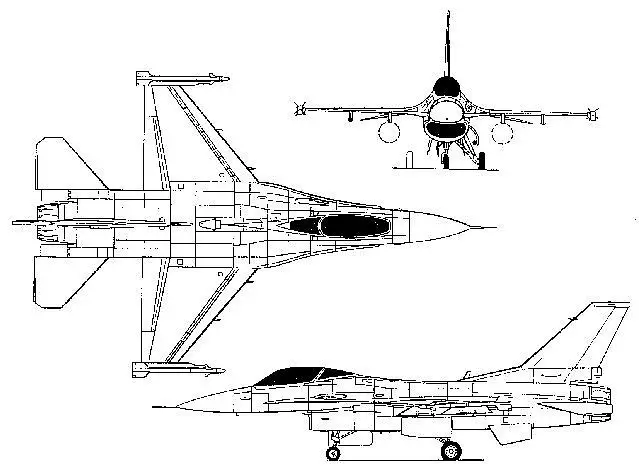 |
||||||||||||||||||
|
||||||||||||||||||

